“IF YOU LIKE MY SKIN SO MUCH GO PAINT YOURSELVES IN STRIPES.
THERE ARE JUST 1411 OF US LEFT.
SOON THERE WILL BE NONE.
BACHAO DOST!”

Dolphins are marine mammals that are closely related to whales and porpoises. There are almost forty species of dolphin in seventeen genera. They vary in size from 1.2 m (4 ft) and 40 kg (90 lb) (Maui’s Dolphin), up to 9.5 m (30 ft) and 10 tonnes (9.8 LT; 11 ST) (the Orca or Killer Whale). They are found worldwide, mostly in the shallower seas of the continental shelves, and are carnivores, mostly eating fish and squid. The family Delphinidae is the largest in the Cetacea, and relatively recent: dolphins evolved about ten million years ago, during the Miocene. Dolphins are considered to be amongst the most intelligent of animals and their often friendly appearance and seemingly playful attitude have made them popular in human culture.
| Contents |
// Origin of the name

The name is originally from Ancient Greek δελφίς (delphís; “dolphin”), which was related to the Greek δελφύς (delphys; “womb”). The animal’s name can therefore be interpreted as meaning “a ‘fish’ with a womb”.[1] The name was transmitted via the Latin delphinus, Middle Latin dolfinus and the Old French daulphin, which reintroduced the ph into the word.
The word is used in a few different ways. It can mean:
The River Dolphin:

The Killer Whale:

A group of dolphins can be called a “school” or a “pod”. Male dolphins are called “bulls”, females “cows” and young dolphins are called “calves”.[2]

Hybrid dolphins
The best known hybrid however is the Wolphin, a False Killer Whale-Bottlenose Dolphin hybrid. The Wolphin is a fertile hybrid, and two such Wolphins currently live at the Sea Life Park in Hawaii, the first having been born in 1985 from a male False Killer Whale and a female Bottlenose. Wolphins have also been observed in the wild.[7]
Evolution
Dolphins, along with whales and porpoises, are descendants of terrestrial mammals, most likely of the Artiodactyl order. The ancestors of the modern day dolphins entered the water roughly fifty million years ago, in the Eocene epoch.
Anatomy
Though it varies per species, basic colouration patterns are shades of grey usually with a lighter underside. It is often combined with lines and patches of different hue and contrast.
.The dolphin brain is large and highly complex and is different in structure from that of most land mammals.
Senses
Most dolphins have acute eyesight, both in and out of the water, and their perception of sound extends ten times or more above the upper limit of adult human hearing.[11] Though they have a small ear opening on each side of their head, it is believed that hearing underwater is also if not exclusively done with the lower jaw which conducts the sound vibrations to the middle ear via a fat-filled cavity in the lower jaw bone. Hearing is also used for echolocation, which seems to be an ability all dolphins have. It is believed that their teeth are arranged in a way that works as an array or antenna to receive the incoming sound and make it easier for them to pinpoint the exact location of an object.[12] The dolphin’s sense of touch is also well-developed, with free nerve endings being densely packed in the skin, especially around the snout, pectoral fins and genital area. However, dolphins lack an olfactory nerve and lobes and thus are believed to have no sense of smell,[13] but they can taste and do show preferences for certain kinds of fish. Since dolphins spend most of their time below the surface normally, just tasting the water could act in a manner analogous to a sense of smell.
Though most dolphins do not have any hair, they do still have hair follicles and it is believed these might still perform some sensory function, though it is unclear what exactly this may be.[14] The small hairs on the rostrum of the Boto river dolphin are believed to function as a tactile sense however, possibly to compensate for the Boto’s poor eyesight.[15]
Social behaviour
Friendly Dolphins:

Dolphins are social, living in pods (also called “schools”) of up to a dozen individuals. In places with a high abundance of food, pods can join temporarily, forming an aggregation called a superpod; such groupings may exceed a thousand dolphins. The individuals communicate using a variety of clicks, whistles and other vocalizations. They also use ultrasonic sounds for echolocation. Membership in pods is not rigid; interchange is common. However, the cetaceans can establish strong bonds between each other. This leads to them staying with injured or ill individuals, even actively helping them to breathe by bringing them to the surface if needed.[16] This altruistic behaviour does not appear to be limited to their own species however. A dolphin in New Zealand that goes by the name of Moko has been observed to seemingly help guide a female Pygmy Sperm Whale together with her calf out of shallow water where they had stranded several times.[17] They have also been known to seemingly protect swimmers from sharks by swimming circles around the swimmers[18][19] or charging the sharks to make them go away.[citation needed]
Dolphins also show cultural behaviour, something long believed to be a quality unique to humans (or to humans and some other primate species). In May 2005, a discovery was made in Australia which shows this cultural aspect of dolphin behaviour: Some dolphins, such as the Indo-Pacific Bottlenose Dolphin (Tursiops aduncus) teach their young to use tools. The dolphins break sponges off and cover their snouts with them thus protecting their snouts while foraging. This knowledge of how to use a tool is mostly transferred from mothers to daughters, unlike simian primates, where the knowledge is generally passed on to both sexes. The technology to use sponges as mouth protection is not genetically inherited but a taught behaviour.[20] Another such behaviour was discovered amongst river dolphins in Brazil, where some male dolphins apparently use objects such as weeds and sticks as part of a sexual display.[21]
Dolphins are known to engage in acts of aggression towards each other. The older a male dolphin is, the more likely his body is covered with scars ranging in depth from teeth marks made by other dolphins. It is suggested that male dolphins engage in such acts of aggression for the same reasons as humans: disputes between companions or even competition for other females. Acts of aggression can become so intense that targeted dolphins are known to go into exile, leaving their communities as a result of losing a fight with other dolphins.
Male Bottlenose Dolphins have been known to engage in infanticide. Dolphins have also been known to kill porpoises for reasons which are not fully understood, as porpoises generally do not share the same fish diet as dolphins and are therefore not competitors for food supplies.[22]
Feeding
Various methods of feeding exist, not just between species but also within a species. Various methods may be employed, some techniques being used by only a single dolphin population. Fish and squid are the main source of food for most dolphin species, but the False Killer Whale and the Killer Whale also feed on other marine mammals.
One feeding method employed by many species is herding, where a pod will control a school of fish while individual members take turns plowing through the school, feeding. The tightly packed school of fish is commonly known as a bait ball. Coralling is a method where fish are chased to shallow water where they are more easily captured. In South Carolina, the Atlantic Bottlenose Dolphin takes this one step further with what has become known as strand feeding, where the fish are driven onto mud banks and retrieved from there.[26] In some places, Orcas will also come up to the beach to capture sea lions. Some species also whack fish with their fluke, stunning them and sometimes sending fish clear out of the water.
Reports of cooperative human-dolphin fisheries date back to the ancient Roman author and natural philosopher Pliny the Elder.[27] A modern human-dolphin fishery still takes place in Laguna, Santa Catarina, Brazil. Here, dolphins drive fish towards fishermen waiting along the shore and give them a signal when they can cast their nets. The dolphins then feed off the fish that manage to escape the nets.[28][29]
Vocalizations
Dolphins are capable of making a broad range of sounds using nasal airsacs located just below the blowhole. Roughly three categories of sounds can be identified however; frequency modulated sounds which are usually just called whistles; burst-pulsed sounds and clicks. Whistles are used by dolphins to communicate, though the nature and extent of their ability to communicate in this way is not known. Research has shown however that at least some dolphin species are capable of sending identity information to each other using a signature whistle; a whistle that refers specifically to the identity of a certain dolphin. The burst-pulsed sounds are also used for communication, but again the nature and extent of communication possible this way is not known.[30] The clicks are directional and used by dolphins for echolocation and are often in a short series called a click train, the rate increasing when approaching an object of interest. Dolphin echolocation clicks are amongst the loudest sounds made by animals in the sea.[31]
Jumping and playing
Dolphins occasionally leap above the water surface, sometimes performing acrobatic figures (e.g. the Spinner Dolphin). Scientists are not always quite certain about the purpose of this behaviour and the reason for it may vary; it could be to locate schools of fish by looking at above-water signs like feeding birds, they could be communicating to other dolphins to join a hunt, attempting to dislodge parasites, or simply doing it for fun.
Play is a fairly important part of dolphins’ lives, and they can be observed playing with seaweed or play-fighting with other dolphins. At times they also harass other local creatures, like seabirds and turtles. Dolphins also seem to enjoy riding waves and frequently ‘surf’ coastal swells and the bow waves of boats. Occasionally, they’re also willing to playfully interact with human swimmers.
Sleeping
Because dolphins need to come up to the surface to breathe and have to be alert for possible predators, they do not sleep in the same way land mammals do. Generally, dolphins sleep with only one brain hemisphere in slow-wave sleep at a time, thus maintaining some amount of consciousness required to breathe and keeping one eye open to keep a watch out for possible threats. The earlier stages of sleep can be observed in both hemispheres of the brain, however.[32][33][34]
However, in captivity, dolphins have been observed to seemingly enter a fully asleep state where both eyes are closed and the animal does not respond to mild external stimuli, respiration being automatic with a tail kick reflex keeping the blowhole above the water. If not needed to keep the blowhole above the water, the tail kick reflex may subside. Dolphins kept unconscious using anesthetics initially show a similar tail kick reflex.[35] Though a similar state has been observed with wild Sperm Whales, it is not known if this state is ever reached in the wild amongst any dolphin species.[36]
Threats
Natural threats
Except for humans (discussed below), dolphins have few natural enemies, some species or specific populations having none at all making them apex predators. For most smaller species of dolphins, only a few larger species of shark such as the bull shark, dusky shark, tiger shark and great white shark are a potential risk, especially for calves. Some of the larger dolphin species such as Orcas may also prey on some of the smaller dolphin species, but this seems rare. Dolphins may also suffer from a wide variety of diseases and parasites.
Human threats
Some dolphin species face an uncertain future, especially some of the river dolphin species such as the Amazon River Dolphin, and the Ganges and Yangtze River Dolphin, all of which are critically or seriously endangered. A 2006 survey found no individuals of the Yangtze River Dolphin, leading to the conclusion that the species is now functionally extinct.[37]
Contamination of environment – the oceans, seas, and rivers – is an issue of concern, especially pesticides, heavy metals, plastics, and other industrial and agricultural pollutants which do not disintegrate rapidly in the environment are reducing dolphin populations, and resulting in dolphins building up unusually high levels of contaminants. Injuries or deaths due to collisions with boats, especially their propellers, are also common.
Various fishing methods, most notably purse Seine fishing for tuna and the use of drift and gill nets, results in a large amounts of dolphins being killed inadvertently.[38] Accidental by-catch in gillnets and incidental captures in antipredator nets used in marine fish farms are common and poses a risk for mainly local dolphin populations.[39][40] Dolphin safe labels have been introduced to reassure consumers that the fish sold has been caught in a dolphin friendly way. In some parts of the world such as Taiji in Japan and the Faroe Islands, dolphins are traditionally considered as food, and killed in harpoon or drive hunts.
It is believed that loud underwater noises, for example resulting from naval sonar use, live firing exercises or certain offshore construction projects such as the construction of offshore wind farms may be harmful to dolphins, distressing the animals, damaging their hearing and possibly forcing them to the surface quicker resulting in decompression sickness.[41][42]
Human–dolphin relationships
Dolphins have long played a role in human culture. Dolphins are common in Greek mythology and there are many coins from the time which feature a man or boy riding on the back of a dolphin. The Ancient Greeks treated them with welcome; a ship spotting dolphins riding in their wake was considered a good omen for a smooth voyage. In Hindu mythology, the Ganges River Dolphin is associated with Ganga, the deity of the Ganges river.
Popular culture
In more recent times, the 1963 Flipper movie and the subsequent popular Flipper television series, contributed to the popularity of dolphins in Western society. The series, created by Ivan Tors, portrayed a dolphin in a friendly relationship with two boys, Sandy and Bud; a kind of seagoing Lassie. Flipper, a Bottlenose Dolphin, understood English commands unusually well and was a marked hero. A second Flipper movie was made in 1996, which was based on the story of the original movie. A Bottlenose Dolphin also played a prominent role in the 1990s science fiction television series seaQuest DSV in which the animal, named Darwin, could communicate with English speakers using a vocoder, a fictional invention which translated the clicks and whistles to English and back.
More well known from this time period is probably the movie Free Willy however, which made famous the Orca playing Willy, Keiko. The 1977 horror movie Orca paints a less friendly picture of the animal. Here, a male Orca takes revenge on fishermen after the killing of his mate. In the 1973 movie The Day of the Dolphin trained dolphins are kidnapped and made to perform a naval military assassination using explosives.
Dolphinariums

See also: Dolphinarium
The renewed popularity of dolphins in the 1960s resulted in the appearance of many dolphinariums around the world, which have made dolphins accessible to the public. Though criticism and more strict animal welfare laws have forced many dolphinariums to close their doors, hundreds still exist around the world attracting a large amount of visitors. In the United States, best known are the SeaWorld marine mammal parks, and their common Orca stage name Shamu, which they have trademarked, has become well known. Southwest Airlines, an American airline, has painted three of their Boeing 737 aircraft in Shamu colours as an advertisement for the parks and have been flying with such a livery on various aircraft since 1988.
Therapy
Dolphins are an increasingly popular choice of animal-assisted therapy for psychological problems and developmental disabilities. For example, a 2005 study with 30 participants found it was an effective treatment for mild to moderate depression.[43] However, this study was criticized on several grounds; for example, it is not known whether dolphins are more effective than common pets.[44] Reviews of this and other published dolphin-assisted therapy (DAT) studies have found important methodological flaws and have concluded that there is no compelling scientific evidence that DAT is a legitimate therapy or that it affords any more than fleeting improvements in mood.[45]
Military
A number of militaries have employed dolphins for various purposes from finding mines to rescuing lost or trapped humans. Such military dolphins, however, drew scrutiny during the Vietnam War when rumors circulated that dolphins were being trained by the United States Navy to kill Vietnamese divers.[46] However, no evidence to support these rumors ever surfaced, and the United States Navy denies that at any point Dolphins were trained to do harm. Dolphins are still being trained by the United States Navy as part of the U.S. Navy Marine Mammal Program. The Russian military is believed to have closed its marine mammal program in the early 1990s. In 2000 the press reported that dolphins trained to kill by the Soviet Navy had been sold to Iran.[47]
Literature
Dolphins are also common in contemporary literature, especially science fiction novels. A military role for dolphins is found in William Gibson‘s short story Johnny Mnemonic, in which cyborg dolphins are used in war-time by the military to find submarines and, after the war, by a group of revolutionaries to decode encrypted information. Dolphins play a role as sentient patrollers of the sea enhanced with a deeper empathy toward humans in Anne McCaffrey‘s The Dragonriders of Pern series. In the Known Space universe of author Larry Niven, dolphins also play a significant role as fully-recognised “legal entities”. More humorous is The Hitchhiker’s Guide to the Galaxy, in which dolphins are the second most intelligent creatures on Earth (after mice, and followed by humans) and tried in vain to warn humans of the impending destruction of the planet. However, their behaviour was misinterpreted as playful acrobatics. Their story is told in So Long, and Thanks for All the Fish. Much more serious is their major role (along with chimpanzees) in David Brin‘s Uplift series. A talking Dolphin called “Howard” helps Hagbard Celine and his submarine crew fight the evil Illuminati in Robert Shea and Robert Anton Wilson‘s Illuminatus Trilogy.
Dolphins also appear frequently in non-science fiction literature however. In the book The Music of Dolphins by author Karen Hesse, a girl is raised by dolphins from the age of four until she is discovered by the coast guard. Fantasy author Ken Grimwood wrote dolphins into his 1995 novel Into the Deep about a marine biologist struggling to crack the code of dolphin intelligence, including entire chapters written from the viewpoint of his dolphin characters. In this book, humans and dolphins are capable of communicating via telepathy.
Art
Greek Art:

Dolphins are a popular artistic motif, dating back to ancient times. Examples include the Triton Fountain by Bernini and depictions of dolphins in the ruined Minoan palace at Knossos and on Minoan pottery.





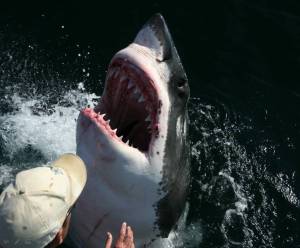
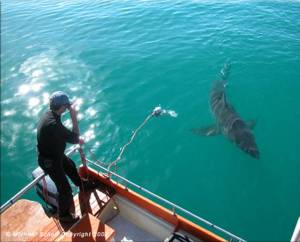
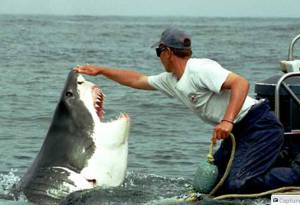
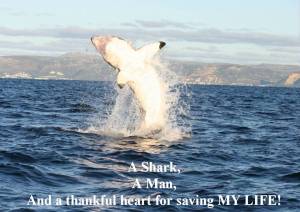
The story still goes on off the South Australian coast near Port Lincoln.

1. Teamwork. Don’t worry, for every solution they have a problem

2. Smile at you boss’s joke however stupid it is

3. Nothing is impossible

4. Achieve greater heights
|
The Shark
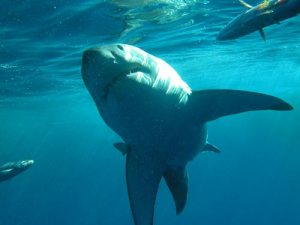
In the silent abyss of our oceans it moves with the deadliness of a striking submarine. The Shark’s reign spreads across vast oceans reaching down up to a depth of 10000 feet. Undeniably it is an enigmatic creature of nature’s vast water worlds and understandably it evokes reactions of fear and horror. None of us could have actually seen a shark in reality but when we stand on the safety of our shores we wonder whether there’s one lurking around. The Shark is familiar to all of us invoking images of ferocious attacks as depicted in movies, books, pictures and dailies. It’s commonly seen as an instinctive killing machine, yet it has an intelligence equal to higher mammals on our terrain. Like every predator it moves around in silent cruelty. And like every predator it’s linked to nature’s grand designs of bio-balances and counter balances.Yet this hunting creature is itself the victim of human hunters. Today the Shark is an endangered species, sought after for its fins which are much desired delicacies in many Asian countries. Recipes, when ordered, are status symbols on the table. The fin soup and dishes are also laced with myths and dubious ideas on a sharks medicinal and curative properties.
There are world wide efforts to protect and preserve the shark.
To know the shark is to admire and preserve it as our planet’s natural heritage, so rich and so beautiful. Let’s not lose the Sharks existence only to watch it hanging from some museum.
In the meantime, from a marine biologist’s point of view this fish is still a puzzle. A mystery of myriad forces waiting to be unraveled by the biological laws and insights of science.
Read on.
Contrary to belief that a Shark is a mindless killing machine, it has intelligence similar to that of higher territorial mammals . They are said to have a sense of curiosity, problem solving skills and they engage in playful activities.
Movement:
They swim at an average speed of 8 kms/hr ( 5 mph) and when attacking they can reach a speed of 18 lms/hr ( 12 mph).
Body:
Sharks have a highly streamlined body and a cartilaginous skeleton. The skeleton of a shark is different from other fish which are bony. The shark’s skeleton is made of flexible dense tissue that is considered as bone.
SIZE:
Dwarf Lantern Shark: 17 cms ( 7 inches) in length. Deep sea species
Whale Shark: Considered the largest. 12 meters ( 30 feet)
Bull Shark: Best known shark that lives in both fresh water and sea water
Sharks live as deep as 7000 ft. ( 2000 meters). Some live even deeper at 3000 meters ( 10000 ft.)
Diet: Plankton, squid, small fish and mammals. Some like the tiger shark eat almost everything. However most sharks have specific diets that they search for.
Teeth: Shark have powerful cutter teeth which can be replaced every 8-10 days or in several months. A shark can lose 30000 teeth in their lifetime.
Smell: They have a keen sense of smell. Some sharks can detect one part in millions of blood in sea water.
Hearing: Sharks have a sharp sense of hearing and hear their prey many miles away. They also have an electrical sensitivity to detect prey even when they are hiding. Sometimes sharks confuse these electrical fields with those of metal boats and attack the boats, confusing them with prey. Ocean currents and magnetic fields of the earth are used by sharks to sense their way in navigation
Shark Babies:
Shark pups are born in three ways.
1. Oviparity – Where eggs are laid
2. Viviparity – Young are born alive and functional like mammals
3. Ovoviviparity – Where eggs hatch inside the mother’s body and are nourished with yolk and body fluids.
Life Span: Life span varies from species to species. The average life span of most sharks is 20-30 years.
Spiny Dogfish: 100 years
Whale Shark: Over 100 years
Sharks are considered as solitary predators but some are highly social. Many meet together for breeding. Their hunting grounds can range up to thousands of miles where they can cover entire sea basins.
Sharks and Humans:
Sharks are common sea food in many places around the world.
Japan and Australia: Used to make fish and chips, deep fried, crumbed, fried or grilled.
India: Small baby sharks called SORA in Tamil Nadu are fried in oil and spices. Even the bones are considered a delicasy.
Greenland: Sharks are made in HAKARL or fermented shark. it is regarded as a national dish.
Sharks are also killed for their fins out of which soup is made. Fishermen cut the fins and throw the live shark back into the sea. The immobile creature is attacked by predators or dies out of suffocation. This practice is rare but shark fins are a major trade in black markets with fins priced at $ 220/lb. Killing of sharks is illegal and many governments are enforcing laws to protect sharks. the UN has acknowledged the need for shark fishery management. In Asia, there is a demand for fin soup and it’s a status symbol. This finning is leading to shark extinction.
Sharks are not suitable for domestic acqariums. They are too expensive and difficult to maintain.

Jackal
The silver backed Jackal

The jackal (from Turkish çakal, via Persian shaghal ultimately from Sanskrit sṛgālaḥ [1][2]) is a member of any of three (sometimes four) small to medium-sized species of the family Canidae, found in Africa, Asia and southeastern Europe.[3] Jackals fill a similar ecological niche to the coyote in North America, that of predators of small to medium-sized animals, scavengers, and omnivores. Their long legs and curved canine teeth are adapted for hunting small mammals, birds and reptiles. Big feet and fused leg bones give them a long-distance runner’s physique, capable of maintaining speeds of 16 km/h (9.9 mph) for extended periods of time. They are crepuscular, most active at dawn and dusk.
In jackal society the social unit is that of a monogamous pair which defends its territory from other pairs. These territories are defended by vigorously chasing intruding rivals and marking landmarks around the territory with urine and feces. The territory may be large enough to hold some young adults who stay with their parents until they establish their own territory. Jackals may occasionally assemble in small packs, for example to scavenge a carcass, but normally hunt alone or as a pair.
//
Use in slang
The popular, although rather inaccurate image of jackals is as scavengers, and this has resulted in a somewhat negative image.

 A fox is an animal of small to medium-sized canids, characterized by possessing a long, narrow snout, and a bushy tail, or brush. By far the most common and widespread species of fox is the red fox (Vulpes vulpes), although various species are found on almost every continent. The presence of fox-like carnivores all over the globe has led to their appearance in both popular culture and folklore
A fox is an animal of small to medium-sized canids, characterized by possessing a long, narrow snout, and a bushy tail, or brush. By far the most common and widespread species of fox is the red fox (Vulpes vulpes), although various species are found on almost every continent. The presence of fox-like carnivores all over the globe has led to their appearance in both popular culture and folklore
In the wild foxes can live for up to 10 years, but most foxes only live for 2 to 3 years due to hunting, road accidents and diseases. Foxes are generally smaller than other members of the family Canidae such as wolves, jackals, and domestic dogs. Dogs (male foxes) weigh on average, 5.9 kilograms (13 lb) and vixens (female foxes) weigh less, at 5.2 kilograms (11.5 lb). Fox-like features typically include an acute muzzle (a “fox face”) and bushy tail.

Unlike many canines foxes are not usually pack animals. Typically, they live in small family groups, opportunistic feeders that hunt live prey (especially rodents). Using a pouncing technique practiced from an early age, they are usually able to kill their prey quickly. Foxes also gather a wide variety of other foods ranging from grasshoppers to fruit and berries.
Foxes are normally extremely wary of humans and are not usually kept as indoor pets; however, the silver fox was successfully domesticated in Russia after a 45 year selective breeding program. This selective breeding also resulted in physical and behavioral traits appearing that are frequently seen in domestic cats, dogs, and other animals: pigmentation changes, floppy ears, and curly tails. [4] Certain people have domesticated the fennec fox, red fox, arctic fox, and many other fox breeds, however.
Diet
The diet of foxes is largely made up of invertebrates. However, it also includes rodents, rabbits and other small mammals, reptiles, (such as snakes), amphibians, grasses, berries, fruit, fish, birds, eggs, and all other kinds of small animals. Many species are generalist predators, but some (such as the crab-eating fox) are more specialist. Most species of foxes generally consume around 1 kg of food every day. Foxes cache excess food, burying it for later consumption, usually under leaves, snow, or soil.

Foxes are readily found in cities and cultivated areas and (depending upon species) seem to adapt reasonably well to human presence.
Foxes have been successfully employed to control pests on fruit farms while leaving the fruit intact.[5]
Relationships with humans
Fox attacks on humans are not common but have been reported. In November 2008 an incident in Arizona, USA was reported in which a jogger was attacked and bitten by a rabid fox.[6]
Fox hunting
Fox hunting is a controversial sport that originated in the United Kingdom in the 16th century. Hunting with dogs is now banned in the United Kingdom[7], though hunting without dogs is still permitted. The sport is practiced in several other countries including Australia, Canada, France, Ireland, Italy, Russia and the United States.

Domestication
The Russian Silver Fox, or Domesticated Silver Fox, is the result of nearly 50 years of experiments in the Soviet Union and Russia to domesticate the silver morph of the Red Fox. Notably, the new foxes not only became more tame, but more dog-like as well: they lost their distinctive musky “fox smell”, became more friendly with humans, put their ears down (like dogs), wagged their tails when happy and began to vocalize and bark like domesticated dogs. The breeding project was set up by the Russian scientist Dmitri Belyaev.

The safest way to handle foxes:
